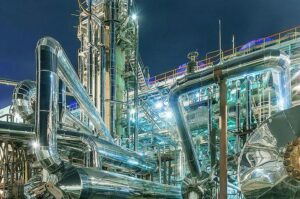
Preface. In chapter 4 of my book “Life After Fossil Fuels: A Reality Check on Alternative Energy“, I explain how it came to be that fertilizer is made out of natural gas, using the energy of natural gas, and why it allows at least 4 billion of us to be alive. Yet natural gas is finite. And now there are shortages due to high prices. In the U.S. Congress voted to allow natural gas to be exported several years ago, partly to help Europeans not become dependent on Russian gas and fall into their sphere of influence. But now it’s costing farmers all over the world so much many will go out of business. In the U.S., especially small farmers who don’t get subsidies like the huge farms do.
High Natural gas prices in the news:
2022 Rising price of fertilizer is forcing NC farmers out of the business. North Carolina farmers say the cost of fertilizer has tripled over the past two years and is threatening to drive smaller farms out of the business entirely. The spike in cost has left family farms looking for ways to stay afloat while still producing enough food. As one of the most essential tools in agriculture, fertilizer makes up 15% of all farming costs in the U.S., according to the American Farm Bureau Federation. But since September 2020, the cost of fertilizer nationwide has spiked up to 300% as demand for its primary ingredients like ammonia and liquid nitrogen has soared. One farmer said that “Now everybody’s going to chicken litter, and we can’t even find the chicken litter now to do for our farm.”
Alice Friedemann www.energyskeptic.com Author of Life After Fossil Fuels: A Reality Check on Alternative Energy; When Trucks Stop Running: Energy and the Future of Transportation”, Barriers to Making Algal Biofuels, & “Crunch! Whole Grain Artisan Chips and Crackers”. Women in ecology Podcasts: WGBH, Planet: Critical, Crazy Town, Collapse Chronicles, Derrick Jensen, Practical Prepping, Kunstler 253 &278, Peak Prosperity, Index of best energyskeptic posts
***
2021 This Chemical Is in Short Supply, and the Whole World Feels It. New York Times.
People and industries of all kinds are feeling the shocks. In India, a lack of urea has made farmers fear for their livelihoods; fears of fertilizer shortages have led crowds of desperate farmers to gather outside government distribution centers and clash with the police. In South Korea, it meant truck drivers couldn’t start their engines.
One big reason for surging fertilizer prices is surging prices of coal and natural gas. China and Russia, two of the biggest producers, have restricted exports to ensure supplies for their own farmers. In China’s case, an energy crunch led some areas to ration electricity, which forced fertilizer factories to slash production. Hurricane Ida drove several large chemical plants to suspend operations when it tore through the U.S. Gulf Coast in August. Western sanctions on Belarus have hit that nation’s production of potash, the key ingredient in another fertilizer. Port delays and high freight fees — plant food is bulky stuff — have added to costs.
Urea is an important type of agricultural fertilizer, so rising prices could ultimately mean higher costs at dinner tables around the world. The United Nations Food and Agriculture Organization’s index of food prices is already at its highest level since 2011. The coronavirus pandemic has caused huge numbers of people to face hunger, and increased food prices could cause even more to have trouble meeting basic dietary needs.
As prices of urea solution soared as much as tenfold last month, some South Korean truck drivers said they had forfeited jobs that would consume more urea, such as ones involving long distances or big hills. On a construction site, if just one heavy-duty vehicle runs out of urea, the entire project might be paralyzed.
“If my truck stops, my family’s livelihood, my children’s tuition, everything stops,” said Kim Jung-suk, 47, who drives a dump truck in Seoul.
2021. Poorest face food crisis amid fertiliser shortage. BBC.
Svein Tore Holsether, chief executive of Yara International, said higher [natyral] gas prices were pushing up fertiliser costs and affecting food prices worldwide.
Fertiliser requires large amounts of gas in its production.
Mr Holsether said Yara had been forced to cut some production due to higher gas prices, which had led to shortages.
The chief executive said developing countries would be hit hardest by the shortages, with crop yields declining and food prices rising.
“It’s really scary, we are facing a food crisis and vulnerable people are being hit very hard,” he told the BBC’s Today program. “It’s impacting food prices all over the world and it hits the wallets of many people. But for some people, especially in the developing world, this is not only a question about the wallet, but it’s a question of life or death.”
Less fertiliser, Mr Holsether said, meant farmers in developing countries would not be able to plant as efficiently, leading to smaller crops.
Farmers apply fertilizers to boost yields of crops such as corn, canola and wheat. The process of creating ammonia, which is present in many fertilisers, currently relies on hydropower or natural gas.
‘Volatile’
The increase in gas prices in recent months has been triggered by several factors which have increased demand, including the unlocking of economies during the pandemic and reduced wind or rain for renewable power.
This has led to a sharp rise in the cost of producing fertiliser, with the price of ammonia – the product Yara International produces more than anyone in the world – up 255% on last year.
Mr Holsether said the situation was “very volatile” and called for support and funding for the World Food Programme “to avoid famine at massive scale. It says a lot about the impact that fertiliser can have.

One Response to Limits to Growth: Natural gas fertilizer that feeds 4 billion of us